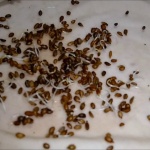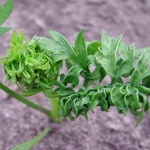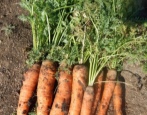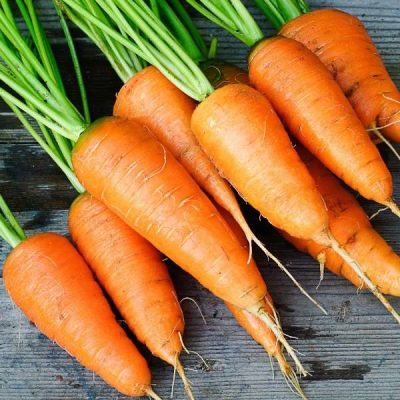
- Authors: France
- Appointment: for fresh consumption, for canning, for freezing, for bundled products, for making juice
- Leaf rosette shape: semi-spreading
- Leaves: finely dissected, green, medium size
- Weight, g: 80-160
- The form : conical with blunt tip
- Taste qualities: excellent
- Ripening terms: mid-early
- Length, cm: 9-15
- Diameter, cm: 2-3
Getting lost when choosing a carrot variety for planting in a garden ridge, it is recommended to give preference to proven, so to speak, classic varieties that are characterized by ease of care, but give high yields. It is with such indicators that the mid-early variety Carotel, bred by French botanists, is endowed.
Breeding history
The table variety of carrots Karotel was bred more than 20 years ago by French breeders. The main task of the scientists was to create a vegetable with improved characteristics and the ability to grow in unfavorable climates, for example, in regions with short and cool summers.
The variety is not listed in the State Register of approved for use, but its popularity has been growing over the years. The vegetable is cultivated both on small garden beds and on farm plantations (fields). It is possible to grow carrots in different climatic zones, but vegetable crops are most productive in regions with a temperate climate.
Description of the variety
The French carrot is a powerful rosette plant with semi-spreading leaves. The leaves of the tops are characterized by medium size, pinnately dissected shape and rich green color. A distinctive feature of the plant is a pronounced, rather specific aroma of foliage. It is also worth noting the good resistance of the vegetable crop to flowering (shooting). In addition, a huge advantage of the variety is the complete immersion of the vegetable in the soil, which facilitates the harvesting process - the carrots are easily pulled out of the soil.
Characteristics of the appearance of the plant and root crops
Karotel is a bright representative of medium-sized carrot varieties. The fruits ripen smooth and neat. The average weight of a root crop is 80-120 g, but sometimes it reaches 160 grams. The length of the vegetable is up to 9-15 cm, and the diameter is only 2-3 cm. The shape of the vegetable is conical or cylindrical with a blunt "nose". Ripe carrots are evenly covered with a rich orange color. The skin (bark) of root crops is thin, smooth, shiny, with a small amount of filamentous roots.
The harvested vegetables can be transported without significant losses, as well as stored for a long time in a cool, ventilated and dry place. Good keeping quality is ensured by the fact that the fruits are resistant to cracking and deformation.
Purpose and taste of tubers
Karotel is famous for its excellent taste. The orange flesh has a crunchy, tender and very juicy texture without fiber. The core of the vegetable is very thin. The taste is dominated by sweetness, light sugariness, complemented by a pronounced carrot aroma. The pulp of root vegetables has a high content of carotene and sugar.
The resulting crop can be widely used in cooking - add to hot and cold dishes, pickle, freeze, use for canning vegetables, and also store in the basement until spring.
Maturation
Carotel carrots represent a class of middle early crops. From the moment of emergence of seedlings to full technical maturity, it takes 100-110 days. Germination occurs in 7-10 days. Harvesting takes place from August to October.
Yield
The yield indicators of the variety are excellent, but directly depend on weather conditions. On average, 2-4 kg of juicy carrots can be dug / pulled out from 1 m2 of plantings.In a favorable environment, from 5.6 to 7.7 kg of vegetables are harvested from 1 m2 of plantings.
Growing regions
Carotel carrots are popular not only among Russian vegetable growers. In recent years, it has been massively grown on the territory of Moldova and Ukraine.
Growing and caring
The root crop is cultivated by the seed method. Before planting, seed is treated with insecticides. For planting carrots, grooves are prepared in the ground with a depth of 2-2.5 cm. The distance between the rows should be 15 cm. Planting is carried out according to the 5x7 cm scheme. Sowing is carried out after the air temperature has reached 6-18 degrees. As a rule, you can sow carrots in late April - mid-May. The best predecessors for this carrot species are: onions, tomatoes, cabbage, peas. It is important to know that the variety can be sown for the winter.
Plant agrotechnology consists of a chain of standard activities: weekly watering, sometimes 2 times a week (the soil should be moistened to a depth of 30 cm), the introduction of mineral fertilizers 2 times per season (organic matter is not recommended), periodic thinning, loosening and weeding to remove weeds, as well as the prevention of diseases and insect infestations.
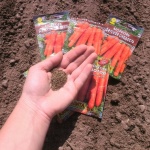
Carrots are one of the most unpretentious crops in terms of growing conditions; they can endure a short drought and a short cold snap. However, to get tasty and large root crops, you should adhere to the basic rules for planting carrots.

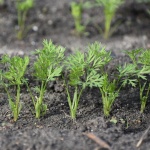
Soil requirements
The root crop is picky about the structure of the soil. It is comfortable to grow carrots in loose, breathable, nutritious and moist soils with a neutral acidity index. It is not recommended to plant a vegetable in lowlands, where moisture is stagnant, as well as in swampy soils.
Required climatic conditions
Karotel has good stress resistance, therefore it tolerates minor temperature fluctuations, cold snaps, short shading. For planting, a sunny area is chosen where it is warm and light, and there is also a reliable barrier that protects against gusty winds and drafts.
Disease and pest resistance
Despite good immunity, a vegetable, if not properly cared for, can be subject to diseases such as phomosis, brown spot, rot and alternaria. The plant can be attacked by flies and carrot flies, spraying with insecticidal preparations will help get rid of them.

Carrots grow in almost any garden. There is an opinion that this culture is very resistant to all kinds of diseases and pests, but this is not the case. Without proper care, carrots become susceptible to all kinds of infections and are affected by harmful insects.


